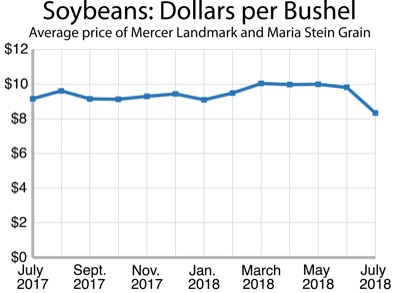Saturday, July 14th, 2018
Soybean farmers may feel impact of tariffs
By Tom Stankard

Photo by Ryan Snyder/The Daily Standard
Price of soybeans in dollars per bushel over the last year.
Local soybean farmers are watching warily to see if they'll be caught in the crossfire of a U.S.-China trade war.
In April, China announced a 25 percent tariff on American soybeans and other agriculture products. The tariff was implemented on July 6, shortly after the U.S. enacted tariffs on $50 billion worth of imports from China.
The tariff comes as the Trump administration is trying to reduce the trade deficit with China, according to two Ohio State University researchers. Professor Ian Sheldon and Farm Management Program Manager Ben Brown recently studied six farms to measure the tariffs' impact.
The study projects a 59 percent loss in annual net income based on trends in yields and projected prices of soybeans and corn, which will be less impacted by the tariffs. Farmer's net annual average income is projected to drop from $63,577 to $26,107 due to low commodity prices, partially caused by the tariffs, Brown and Sheldon concluded.
Local soybean prices have already fallen. Before the trade dispute started in March, the market price for soybeans was $10.03 per bushel. Since then, prices have dropped to $8.31 as of July 1, according to Mercer Landmark and Maria Stein Grain figures.
Mercer County has nearly 3,000 farmers, and about 75 percent of them grow soybeans, Mercer County Farm Service Agency technician Mike Baucher said. Before the tariffs, local farmers had just been starting to recover financially from a tough few years as prices had started to rise.
In total, the U.S. could lose $8 billion to $9 billion worth of soybean exports due to the tariffs, Brown said.
It's too early to to tell the local impact, though, Mercer County OSU Extension Director Denny Riethman added.
The U.S. is the world's largest producer of soybeans, Brown said. Thirty-one percent of Ohio's soybeans are exported to China, making it the state's second-largest buyer, Brown and Sheldon said.
China is the world's largest buyer of soybeans, Brown said. Brazil is the Asian nation's top supplier, followed by the United States. Soybeans are Ohio's largest crop and top agricultural export.
In response to China's tariffs, the U.S. trade representative's office placed tariffs on an additional $200 billion worth of Chinese goods.
An American Soybean Association news release expressed extreme disappointment.
"This action worsens the trade dispute between the two countries, which have already initiated plans to impose $50 billion in tariffs on each other's products."
"We're focused on increasing trade opportunities and keeping the robust and growing Chinese market we have worked for decades to secure," ASA President John Heisdorffer, an Iowa farmer, said in the release. "Our message to the administration and lawmakers remains the same: these tariffs needlessly hurt soy growers and rural communities."
Soybean farmers may not be able to regain their Chinese market share, Brown said.
"That depends on how long the tariffs remain in place, and also how much China substitutes toward importing soybeans from Brazil," Sheldon stated in an email.
Celina-area farmer Dennis Howick said the administration is "trying to get the country back on a level playing field with China."
"In the long run, it will be good a good thing. I'm hoping it ends soon," Howick added.

